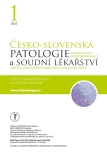Hydrophilic polymer embolization as an iatrogenic complication of endovascular interventions – a new entity
Authors:
Monika Manethová; Ivo Šteiner
Authors‘ workplace:
Fingerlandův ústav patologie, Lékařská fakulta Univerzity Karlovy a Fakultní nemocnice Hradec Králové
Published in:
Čes.-slov. Patol., 57, 2021, No. 1, p. 40-43
Category:
Original Article
Overview
Iatrogenic hydrophilic polymer embolization (HPE) is an underrecognised complication of endovascular procedures. In certain instances, HPE and related complications may lead to patiens death. Incidence of this phenomenon is not known. We evaluated retrospectively all autopsies of patients with a history of endovascular intervention performed by one pathology resident during a period of 8 months. There were 10 cases, which were examined histochemically and in polarized light. We detected HPE in 2 of the 10 cases. In both cases the involved organ were lungs. Hydrophilic polymer embolization is a potential and easy-to-miss complication of endovascular procedures. It must be considered during histological examination of autoptic material.
Keywords:
iatrogenic embolization – hydrophilic polymers – HPE – Catheterization
Sources
1. Mehta RI, Mehta RI, Choi JM, et al. Hydrophilic polymer embolism and associated vasculopathy of the lung: prevalence in a retrospective autopsy study. Hum Pathol 2015; 46 : 191-201.
2. Hickey TB, Honig A, Ostry AJ, et al. Iatrogenic embolization following cardiac intervention: postmortem analysis of 110 cases. Cardiovasc Pathol 2019; 40 : 12-18.
3. Mehta RI, Mehta RI. Hydrophilic Polymer Embolism: An Update for Physicians. Am J Med 2017; 130: e287-e290.
4. Shi H, Wang J, Vorvolakos K, et al. Pre-clinical evaluation of surface coating performance in guidewire surrogates: Potential implications for coated interventional surgical devices. J Biomater Appl 2019 : 885328219884453.
5. Thompson AK, Peters MS, El-Azhary RA, et al. Cutaneous microemboli from hydrophilic polymer after endovascular procedures. J Am Acad Dermatol 2015; 73 : 666-671.
6. Chen CL, Chen NC, Wang JS. Acute hydrophilic-polymer nephropathy and acute renal failure. N Engl J Med 2015; 372 : 1775-1776.
7. Chavez JA, Chen W, Frankel WL, et al. Hydrophilic Polymer-associated Ischemic Enterocolitis. Am J Surg Pathol 2017; 41 : 271-276.
8. Simonte G, Isernia G, Fiorucci B, et al. Polymer Embolization and Anaphylactic Reaction during Implantation of an Ovation Stent Graft for Abdominal Aortic Aneurysm Exclusion. Ann Vasc Surg 2018; 50 : 298 e297-298 e211.
9. Chopra AM, Mehta M, Bismuth J, et al. Polymer coating embolism from intravascular medical devices - a clinical literature review. Cardiovasc Pathol 2017; 30 : 45-54.
10. Rapkiewicz A, Hood B, Hutchins K. Fatal Case of Hydrophilic Polymer Emboli. J Forensic Sci 2016; 61 Suppl 1: S268-270.
11. Chopra AM. Analysis: Particulate Limits for Intravascular Devices: Considerations for Polymer Coating Embolism. Biomed Instrum Technol 2019; 53 : 426-432.
12. Allan RW, Alnuaimat H, Edwards WD, et al. Embolization of hydrophilic catheter coating to the lungs: report of a case mimicking granulomatous vasculitis. Am J Clin Pathol 2009; 132 : 794-797.
13. Meiers C, Abebe Y, Alberto NM, et al. Cerebral Granulomatous Inflammation Secondary to Hydrophilic Polymer Embolization Following Thrombectomy. Am J Case Rep 2017; 18 : 507-511.
14. Lorentzen AO, Nome T, Bakke SJ, et al. Cerebral foreign body reaction after carotid aneurysm stenting. Interv Neuroradiol 2016; 22 : 53-57.
15. Rosen LE, Singh RI, Mahon B. Myocardial hydrophilic polymer emboli following cardiac catheterization: a case report and literature review. Cardiovasc Pathol 2014; 23 : 175-177.
16. Geisbush TR, Marks MP, Heit JJ. Cerebral foreign body reaction due to hydrophilic polymer embolization following aneurysm treatment by pipeline flow diversion device. Interv Neuroradiol 2019;25 : 447-453.
17. Yang GK, Mordhorst A, Maguire J, et al. Hydrophilic polymer embolization after thoracic endovascular aortic repair. J Vasc Surg Cases Innov Tech 2019; 5 : 423-426.
Labels
Anatomical pathology Forensic medical examiner ToxicologyArticle was published in
Czecho-Slovak Pathology

2021 Issue 1
Most read in this issue
- A basic immunohistochemical panel for the diagnosis of soft tissue tumors
- Bone lesions – diagnostic approach using immunohistochemistry and molecular pathology
- Secondary pulmonary hypoplasia associated with calcified Meckel´s diverticulum with osseous metaplasia
-
Consensus recommendations from the Czech Head and Neck Cancer Cooperative Group (2019):
definition of surgical margins status, neck dissection reporting, and HPV/p16 status assessment
